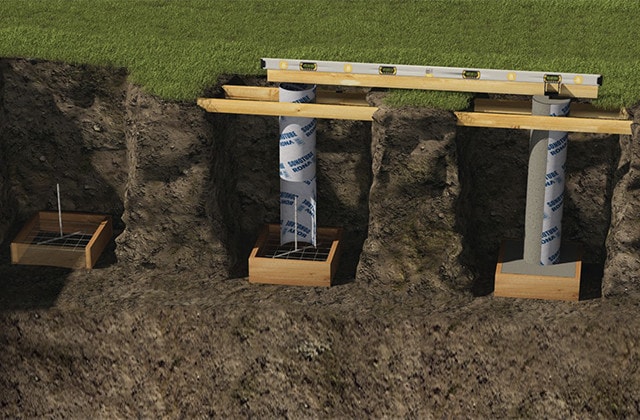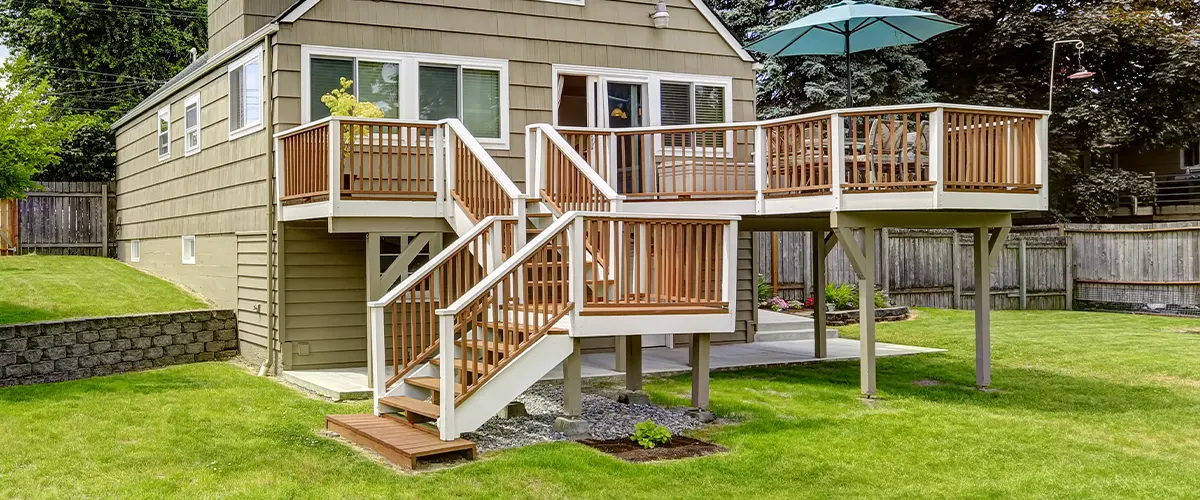Choosing the Right Deck Footings for Security and Longevity
When it involves constructing a deck, among one of the most important decisions you will make is picking the best footings for security and toughness. The durability and safety of your deck depend greatly on the type of grounds you choose, as they provide the essential assistance and stability to hold up against the examination of time. With a myriad of options readily available, it can be overwhelming to determine which footings are best matched for your particular demands. In this conversation, we will certainly check out the numerous sorts of deck grounds, consider the vital elements to consider when deciding, and look into the advantages and disadvantages of different alternatives. By the end, you will have a clearer understanding of the choices available and be better furnished to make an educated decision for your deck task.
Types of Deck Footings
There are a number of sorts of deck footings that can be utilized, each offering special benefits and factors to consider. One common kind of ground is the concrete pier ground. These grounds contain a cylindrical hole loaded with concrete, which provides a solid foundation for the deck messages. Concrete pier footings are fairly easy to install and offer exceptional security, making them a prominent selection for numerous deck projects.
Another sort of ground is the helical heap ground. Helical heaps are steel shafts with helical plates attached to them. These grounds are mounted by screwing them right into the ground, which produces a safe structure for the deck. Helical pile footings are ideal for locations with tough dirt problems, as they can be set up in nearly any kind of dirt. They also permit for simple modification and leveling of the deck if required.
Alternatively, some builders select precast concrete footings. These footings are made of long lasting concrete and be available in various sizes and shapes to fit various deck styles. Precast concrete grounds are practical to install and give a secure base for the deck structure.
Ultimately, another alternative is the post-in-anchor footing system. This kind of footing entails driving a metal support right into the ground and connecting it to the deck message. It provides adaptability in terms of positioning the deck messages and is appropriate for decks with light-weight frameworks.
When selecting the best sort of deck footing, it is necessary to think about variables such as soil problems, deck lots, and neighborhood building ordinance (Deck Footings). Consulting with an expert contractor or structural designer can assist ensure the proper ground is chosen for a steady and secure deck
Factors to Think About When Picking Footings
When choosing the appropriate footings for a deck, it is critical to thoroughly take into consideration various factors such as soil conditions, deck tons, and adherence to regional building regulations. These factors play a considerable duty in ensuring the stability and toughness of the deck framework.
The type of soil on which the deck will certainly be developed establishes the kind of footings required. On the various other hand, decks built on clay or large dirts may require grounds that can fit the soil's tendency to expand and agreement.
One more essential factor is the deck tons. The weight of the deck, including the products made use of and any type of potential real-time lots such as furnishings or events, must be considered when choosing footings. The footings should be designed to birth the weight of the deck and distribute it evenly to avoid any structural problems or failures.
Lastly, adherence to neighborhood building regulations is extremely important. Building ordinance differ from area to area, and it is vital to comply with the specific demands set by the neighborhood authorities. Deck Footings. These codes make certain that the deck is developed securely and meets the essential look these up requirements for architectural stability and load-bearing capability
Concrete Footings: Pros and Disadvantages

When made use of as the foundation for a deck,Concrete footings use numerous advantages and downsides. On the silver lining, concrete footings offer exceptional security and resilience. Concrete is a rigid and strong material that can support heavy lots and endure different weather. It additionally has a lengthy life-span, making it a trusted selection for long-term use.
Another advantage of concrete footings is their versatility. They can be poured into different sizes and shapes to accommodate various deck designs and configurations. Concrete footings can be customized to fit the specific needs and needs of the deck framework.
Nonetheless, there are additionally some drawbacks to making use of concrete footings. One significant downside is the cost and labor involved in their setup. Concrete footings call for excavation and often require the help of heavy equipment. This can raise the total price of the deck project and may require expert support.

Helical Piers Vs. Sonotubes: Which Is Better?
In thinking about the foundation alternatives for a deck, the comparison in between helical piers and sonotubes is critical in figuring out the exceptional choice. They are turned into the ground using hydraulic equipment, supplying a long lasting and secure foundation for the deck.
When it concerns stability and resilience, helical piers have the upper hand. The helical plates on the piers produce a strong grasp with the dirt, stopping any activity or moving of the deck. This is especially advantageous in areas with unpredictable or moving soil problems. Sonotubes, on the various other hand, depend exclusively on the concrete filling for security, which might not provide the same level of strength and resistance.
In regards to installation, helical piers are fairly less complicated and faster to mount compared to sonotubes. The hydraulic machinery More Info made use of to twist the piers right into the ground makes certain a efficient and quick procedure. Sonotubes, on the various other hand, require digging openings and pouring concrete, which can be labor-intensive and time-consuming.
Furthermore, helical piers are a more functional choice. If needed, they can be used in numerous soil problems and can be readjusted or reinforced. Sonotubes, on the various other hand, may need extra assistance, such as rebar, in particular dirt problems or areas with high lots needs.
Selecting the Right Footings for Your Deck's Measurements
For optimal structural stability, it is necessary to thoroughly choose the appropriate footings that align with the measurements of your deck. The measurements of your deck, including its height, width, and length, play a considerable function in figuring out the kind and dimension of grounds required.
When selecting grounds for your deck, it is necessary to consider the load-bearing capacity of the soil. The weight of the deck, combined with the weight of any furniture or people on it, applies a substantial pressure on the grounds (Deck Footings). For that reason, it is critical to pick grounds that can appropriately sustain this weight without sinking or changing over time.
Larger decks with better measurements require bigger footings to provide adequate Your Domain Name stability and assistance. The shape of the footings, whether they are rounded or square, depends on the design and design of the deck.
Conclusion
To conclude, selecting the appropriate deck grounds is vital for ensuring security and longevity. Elements such as the type of footings, the deck's dimensions, and the advantages and disadvantages of different alternatives should be considered. Concrete grounds provide stamina and longevity, however might be much more lengthy and pricey to install. Helical piers and sonotubes have their own benefits and drawbacks. Inevitably, picking the suitable grounds for your deck's specific demands is essential for a effective and long-lasting framework.
These grounds are composed of a round opening filled with concrete, which supplies a strong foundation for the deck blog posts. Concrete pier grounds are relatively easy to install and provide exceptional security, making them a preferred selection for several deck tasks.
Precast concrete grounds are hassle-free to install and provide a stable base for the deck framework.
It supplies adaptability in terms of placing the deck blog posts and is appropriate for decks with lightweight frameworks.
Concrete footings offer numerous benefits and disadvantages when utilized as the foundation for a deck.